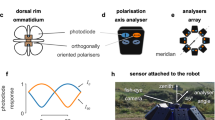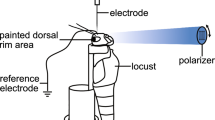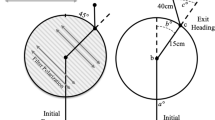Abstract
Desert ants, Cataglyphis fortis, perform large foraging excursions during which they continuously compute a home vector that allows them to return to the nest on the shortest way. This type of navigation, termed path integration, needs a compass system and an odometer. Ants use several cues to determine their walking direction, two of the most important ones being the sun position and the polarization pattern of the sky. We tested whether an information transfer is possible from one compass system to the other, which depend on different anatomical substrates. Since the sky’s polarization pattern is detected by UV-photoreceptors located in the dorsal rim area (DRA), we used an orange Perspex filter that eliminated the UV part of the spectrum to prevent the use of the polarization compass. The use of the sun compass could be excluded by appropriate screens. In the critical tests the ants had learned a nest-feeder direction with e.g. the sun compass only, and were later tested with the polarization compass, or vice versa. The results show that a transfer is possible in both directions.




Similar content being viewed by others
References
Baddeley B, Graham P, Husbands P, Philippides A (2012) A model of ant route navigation driven by scene familiarity. PLoS Comput Biol 8:e1002336. doi:10.1371/journal.pcbi.1002336
Batschelet E (1981) Circular Statistics in Biology. Academic Press, London
Bregy P, Sommer S, Wehner R (2008) Nest-mark orientation versus vector navigation in desert ants. J Exp Biol 211:1868–1873. doi:10.1242/jeb.018036
Collett TS, Collett M, Wehner R (2001) The guidance of desert ants by extended landmarks. J Exp Biol 204:1635–1639
Collett M, Chittka L, Collett TS (2013) Spatial memory in insect navigation. Curr Biol 23:789–800. doi:10.1016/j.cub.2013.07.020
Duelli P, Wehner R (1973) The spectral sensitivity of polarized light orientation in Cataglyphis bicolor (Formicidae, Hymenoptera). J Comp Physiol A 86:37–53. doi:10.1007/BF00694476
el Jundi B, Pfeiffer K, Homberg U (2011) A distinct layer of the medulla integrates sky compass signals in the brain of an insect. PLoS One 6:e27855. doi:10.1371/journal.pone.0027855
el Jundi B, Pfeiffer K, Heinze S, Homberg U (2014) Integration of polarization and chromatic cues in the insect sky compass. J Comp Physiol A 200:575–589. doi:10.1007/s00359-014-0890-6
Fent K (1986) Polarized skylight orientation in the desert ant Cataglyphis. J Comp Physiol A 158:145–150
Fent K, Wehner R (1985) Ocelli: a celestial compass in the desert ant Cataglyphis. Science 228:192–194. doi:10.1126/science.228.4696.192
Grah G, Wehner R, Ronacher B (2005) Path integration in a three-dimensional maze: ground distance estimation keeps desert ants Cataglyphis fortis on course. J Exp Biol 208:4005–4011. doi:10.1242/jeb.01873
Graham P, Cheng K (2009) Ants use the panoramic skyline as a visual cue during navigation. Curr Biol 19:935–937. doi:10.1016/j.cub.2009.08.015
Heinze S, Reppert SM (2011) Sun compass integration of skylight cues in migratory monarch butterflies. Neuron 69:345–358. doi:10.1016/j.neuron.2010.12.025
Heß D, Koch J, Ronacher B (2009) Desert ants do not rely on sky compass information for the perception of inclined path segments. J Exp Biol 212:1528–1534. doi:10.1242/jeb.027961
Labhart T (2000) Polarization-sensitive interneurons in the optic lobe of the desert ant Cataglyphis bicolor. Naturwissenschaften 87:133–136. doi:10.1007/s001140050691
Lanfranconi BC (1982) Kompassorientierung nach dem rotierenden Himmelsmuster bei der Wüstenameisen Cataglyphis bicolor. Dissertation, Univerität Zürich
Lebhardt F, Ronacher B (2013) Interactions of the polarization and the sun compass in path integration of desert ants. J Comp Physiol A. doi:10.1007/s00359-013-0871-1
Lebhardt F, Koch J, Ronacher B (2012) The polarization compass dominates over idiothetic cues in path integration of desert ants. J Exp Biol 215:526–535. doi:10.1242/jeb.060475
Müller M, Wehner R (1988) Path integration in desert ants, Cataglyphis fortis. Proc Natl Acad Sci USA 85:5287–5290
Müller M, Wehner R (2007) Wind and sky as compass cues in desert ant navigation. Naturwissenschaften 94:589–594. doi:10.1007/s00114-007-0232-4
Pfeiffer K, Homberg U (2007) Coding of azimuthal directions via time-compensated combination of celestial compass cues. Curr Biol 17:960–965. doi:10.1016/j.cub.2007.04.059
Ronacher B (2008) Path integration as the basic navigation mechanism of the desert ant Cataglyphis fortis (Forel, 1902) (Hymenoptera: Formicidae). Myrmecol News 11:53–62
Ronacher B, Westwig E, Wehner R (2006) Integrating two-dimensional paths: do desert ants process distance information in the absence of celestial compass cues? J Exp Biol 209:3301–3308. doi:10.1242/jeb.02370
Schwarz S, Albert L, Wystrach A, Cheng K (2011) Ocelli contribute to the encoding of celestial compass information in the Australian desert ant Melophorus bagoti. J Exp Biol 214:901–906. doi:10.1242/jeb.049262
Wehner R (1982) Himmelsnavigation bei Insekten. Neurophysiologie und Verhalten. Neujahrsbl Naturforsch Ges Zürich 184:1–132
Wehner R (1989) Neurobiology of polarization vision. Trends Neurosci 12:353–359. doi:10.1016/0166-2236(89)90043-X
Wehner R (1994) The polarization-vision project: championing organismic biology. In: Schildberger K, Elsner N (eds) Neural basis of behavioural adaptations. Fischer G, Stuttgart, pp 103–143
Wehner R (1997) The ant’s celestial compass system: spectral and polarization channels. In: Lehrer M (ed) Orientation and Communication in Arthropods. Birkhäuser, Basel, pp 145–185
Wehner R (2003) Desert ant navigation: how miniature brains solve complex tasks. J Comp Physiol A 189:579–588. doi:10.1007/s00359-003-0431-1
Wehner R, Duelli P (1971) Spatial orientation of desert ants, Cataglyphis bicolor, before sunrise and after sunset. Experientia 27:1364–1366. doi:10.1007/BF02136743
Wehner R, Labhart T (2006) Polarization vision. In: Warrant E, Nilsson DE (eds) Invertebrate Vision. Cambridge University Press, Cambridge, pp 291–347
Wehner R, Müller M (1985) Does interocular transfer occur in visual navigation by ants? Nature 315:228–229. doi:10.1038/315228a0
Wehner R, Müller M (2006) The significance of direct sunlight and polarized skylight in the ant’s celestial system of navigation. Proc Natl Acad Sci USA 103:12575–12579. doi:10.1073/pnas.0604430103
Wehner R, Rossel S (1985) The bee’s celestial compass: a case study in behavioral neurobiology. Fortschr Zool 31:11–53
Wehner R, Srinivasan MV (2003) Path integration in insects. In: Jeffery KJ (ed) The neurobiology of spatial behaviour. Oxford University Press, Oxford, pp 9–30
Wehner R, Gallizzi K, Frei C, Vesely M (2002) Calibration processes in desert ant navigation: vector courses and systematic search. J Comp Physiol A 188:683–693. doi:10.1007/s00359-002-0340-8
Wittlinger M, Wehner R, Wolf H (2006) The ant odometer: stepping on stilts and stumps. Science 312:1965–1967. doi:10.1126/science.1126912
Wolf H, Wehner R (2000) Pinpointing food sources: olfactory and anemotactic orientation in desert ants, Cataglyphis fortis. J Exp Biol 203:857–868
Wystrach A, Beugnon G, Cheng K (2011) Landmarks or panoramas: what do navigating ants attend to for guidance? Front Zool 8:21. doi:10.1186/1742-9994-8-21
Zar JH (1999) Biostatistical Analysis. Prentice Hall, New Jersey
Zeil J (2012) Visual homing: an insect perspective. Curr Opin Neurobiol 22:285–293. doi:10.1016/j.conb.2011.12.008
Acknowledgments
We thank Julia Stephan and Joshua Alcaniz for their help on the field and the anonymous referees for useful suggestions. Special thanks are due to Rüdiger Wehner for his help with the interpretation of the present data and many discussions over the last years. We also want to express our gratitude to the Tunisian government for kindly allowing us to carry out the investigations in this beautiful country. Financial support was provided by grants from the Deutsche Forschungsgemeinschaft DFG (Ro 547/10-1) and the Volkswagen Foundation (I/78 574) to B.R. The experiments comply with the “Principles of animal Care” and with the current German law.
Conflict of interest
The authors declare that they have no conflict of interests.
Author information
Authors and Affiliations
Corresponding author
Additional information
We dedicate this paper to Rüdiger Wehner who initiated research on desert ant navigation and helped it to blossom by infecting so many students and collaborators with his love for the amazing Cataglyphis ants. Rüdiger Wehner truly deserves the title Tabib-en-Neml—the ant doctor—a nickname given to Felix Santschi 100 years ago.
Electronic supplementary material
Below is the link to the electronic supplementary material.
Rights and permissions
About this article
Cite this article
Lebhardt, F., Ronacher, B. Transfer of directional information between the polarization compass and the sun compass in desert ants. J Comp Physiol A 201, 599–608 (2015). https://doi.org/10.1007/s00359-014-0928-9
Received:
Revised:
Accepted:
Published:
Issue Date:
DOI: https://doi.org/10.1007/s00359-014-0928-9




